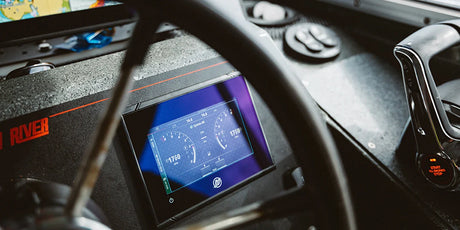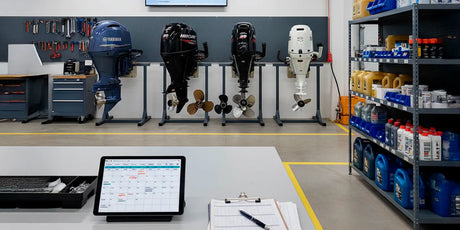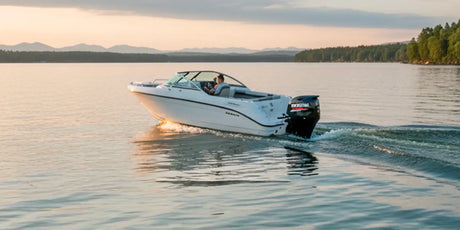Boat battery chargers are essential for maintaining the health and longevity of your boat’s batteries. This comprehensive guide explores the various types of boat battery chargers, their functions, and how to choose the right one for your needs. We will also discuss the benefits of onboard chargers. Finally, we’ll delve into the importance of multi-stage charging and provide tips for installing and using your charger correctly.
By the end of this guide, you will have a thorough understanding of boat battery chargers and be well-equipped to make an informed decision when selecting the best charger for your marine batteries.

Understanding Boat Batteries
Before diving into the intricacies of boat battery chargers, it’s essential to have a basic understanding of the different types of boat batteries and their specific purposes. There are three main types of marine batteries:
Starting Batteries
Starting batteries, also known as cranking batteries, provide a high burst of power for a short period. This is necessary to start your boat’s engine. They are not designed for deep discharging and should not be used to power accessories on your boat.
Deep-Cycle Batteries
Deep-cycle batteries provide steady power over an extended period. They have fewer, thicker plates, which allow them to withstand deep discharging and recharge more effectively. Deep cycle batteries commonly power trolling motors, fish finders, and other accessories on your boat.
Dual-Purpose Batteries
Dual-purpose batteries combine the characteristics of both starting and deep-cycle batteries, providing both high-cranking power and deep-cycle capabilities. These batteries aren’t as efficient as dedicated starting or deep cycle batteries. However, they can be suitable for smaller boats or those with limited space for multiple batteries.
Types of Boat Battery Chargers
There are two general types of chargers, each with its own pros and cons– portable marine battery chargers and onboard boat battery chargers. Additionally, for longer marine battery life, multi-stage charging (conducted by “smart chargers”) is an important technology to be familiar with.
Portable Boat Battery Chargers
Portable boat battery chargers are convenient options for those who need to charge their batteries when away from the boat. These chargers are generally less expensive than onboard chargers. They can be easily moved from one battery to another. However, they can be inconvenient to hook up and switch from battery to battery in the confines of a boat’s battery compartment.
Onboard Boat Battery Chargers
Onboard boat battery chargers are convenient becasue they’re permanently installed on your boat. This means that your entire charging system is already wired. All you need to do is plug the charger into a 120-volt outlet to begin charging your batteries. Onboard chargers are typically more technologically advanced and generally feature multi-stage charging capabilities, which can help prolong the life of your marine batteries.
Smart Chargers for Multi-Stage Boat Battery Charging
Multi-stage boat battery chargers, also known as “smart chargers,” provide optimal charging for your batteries through a series of stages, including bulk, absorption, and float stages. These chargers have microprocessors that regulate the charging process, ensuring that your batteries receive the appropriate voltage and amperage at each stage. This results in faster, more efficient charging, leading to longer battery life and better overall performance.
Choosing the Right Boat Battery Charger
When selecting a boat battery charger, consider several factors to ensure that you choose the best charger for your specific needs. These factors include:
Charger Type
As mentioned earlier, portable, onboard, and multi-stage chargers are available. Consider your charging needs, budget, and the level of convenience you desire when deciding which type of charger is best for you.
Battery Compatibility
Choosing a charger compatible with the chemistry and voltage of your boat batteries is essential. For example, if you have a flooded 12-volt lead-acid starting battery and a 12-volt AGM deep cycle battery, you will need a charger with separate banks for each of those battery types.
Charger Size
The size of your charger, measured in amperage, will determine how quickly your batteries can be recharged. Recommendations for charger size typically range from 10% to 25% of the battery’s amp-hour rating. Remember that higher amperage chargers will result in faster charging times and may be more expensive.
Number of Charging Banks
Consider a charger with multiple charging banks if your boat has multiple batteries. This allows you to charge each battery individually, ensuring that each one receives the appropriate voltage and amperage during the charging process.

The Importance of Multi-Stage Charging
As mentioned, multi-stage charging is a crucial feature of many boat battery chargers, especially onboard chargers. This advanced charging method helps optimize the charging process. It provides the appropriate voltage and amperage at each stage to ensure the best possible charging performance. Multi-stage chargers typically have three stages:
Bulk Stage
The bulk stage is the initial stage of the charging process, during which the charger delivers a constant, maximum current to the battery. This stage accounts for roughly 75-80% of the recharge and helps to replenish the battery’s charge quickly.
Absorption Stage
During the absorption stage, the charger maintains a constant voltage while gradually reducing the current. This stage helps to “top off” the battery, providing the remaining 20-25% of the charge. The absorption stage ensures that the battery reaches a fully charged state without the risk of overcharging.
Float Stage
The float stage is the final stage of the charging process, during which the charger maintains a minimum voltage to keep the battery fully charged without overcharging it. This stage can be maintained indefinitely, allowing you to keep your batteries fully charged and ready for use.
Utilizing smart, multi-stage chargers facilitate faster and fuller charging, leading to longer battery life, more useable battery capacity, less electrolyte loss (wet flooded batteries), and avoiding over-charging and damaging sealed batteries.
How to Charge a Marine Deep Cycle Battery: Essential Tips
To get the most out of your boat battery charger and ensure the longevity of your marine batteries, keep the following tips in mind:
- Always follow the manufacturer’s recommendations for charging and maintaining your specific battery type.
- Regularly inspect your charger and battery connections for signs of corrosion or damage, and clean them as necessary to maintain proper charging performance.
- Use a charger with a float or maintenance mode to prevent overcharging your batteries.
- If you are storing your boat for an extended period, remove the batteries and store them in a cool, dry location. Use a battery maintainer or trickle charger to keep them charged while in storage.
- Periodically check your batteries’ electrolyte levels (if applicable) and refill them with distilled water as needed.
Frequently Asked Questions
What Battery to Power Accessories on a Boat?
A deep-cycle battery is the best choice to power accessories on a boat. Unlike starting batteries, deep-cycle marine batteries are designed for continuous, steady power, making them ideal for running:
- Trolling motors
- Fish finders and GPS units
- Live wells and onboard electronics
- Lighting and sound systems
For boats with limited space, a dual-purpose battery can be used, but a dedicated deep-cycle battery is the best option for longer accessory use without draining the engine’s power source.
Does an Outboard Motor Charge the Battery?
Yes, most modern outboard motors charge the battery while the engine is running. The charging system, often using an alternator or stator, provides a continuous charge to the battery, but the efficiency varies by motor size and RPM.
Key facts:
- Small outboards (<25 HP): May not provide enough charge to fully replenish a battery.
- Mid-size & large outboards (40+ HP): Can produce 5–60 amps, enough to maintain and charge the battery.
- Alternators vs. Stators: Larger outboards have alternators, while smaller ones use stators, which provide less power.
However, an outboard motor alone may not fully recharge a deeply discharged battery, so using a dedicated boat battery charger is still recommended.
Do Boat Motors Charge the Battery?
Yes, most boat motors charge the battery using an alternator or stator system. However, this charge is not always sufficient for fully recharging a deeply drained battery.
- High-output alternators (onboard inboard/outboard engines) provide a continuous charge.
- Outboards with stators generate limited power, meaning additional charging methods are often necessary.
- Using an onboard charger can help keep batteries at full capacity when the boat is not running.
How Long to Charge a Boat Battery?
The time it takes to charge a boat battery depends on the battery’s capacity, charge level, and charger output.
Estimated charging times:
- Trickle Charger (2A): 24-48 hours
- Standard Charger (10A): 8-12 hours
- High-Powered Charger (15-20A): 4-8 hours
- Smart Charger (Multi-Stage, 20A+): 3-6 hours
Tip: To prevent damage, always follow manufacturer-recommended charging guidelines and avoid overcharging.
How Does an Onboard Charger Work?
An onboard charger is a permanently installed multi-bank charging system that provides power to multiple marine batteries simultaneously.
How it Works:
- Connects to shore power (120V AC outlet)
- Charges each battery individually based on its specific needs
- Uses multi-stage charging (bulk, absorption, and float) to optimize battery health
- Prevents overcharging and sulfation, extending battery life
Onboard chargers are ideal for boats with multiple battery banks, providing a set-it-and-forget-it charging system.
Closing Thoughts
Selecting a suitable boat battery charger is crucial for maintaining the health and performance of your marine batteries. By understanding the different types of chargers, their functions, and how to choose the best one for your needs, you can ensure that your batteries receive the proper care they need for a long and successful life on the water. Remember to follow the recommended charging guidelines, regularly inspect your charger and batteries, and utilize multi-stage charging to maximize your batteries’ lifespan. PartsVu is here to help support all of your marine battery charging needs.













2 comments
Dear Jack,
Thank you for your inquiry about using solar power to charge a trolling motor battery. It’s an interesting concept, but there are some practical considerations to keep in mind.
While solar panels are indeed a clean and renewable energy source, the feasibility of using them to charge a trolling motor battery depends on several factors. The primary challenge lies in the amperage requirements of most trolling motors.
For example, a small 30 lb thrust Minn Kota trolling motor can draw up to 30 Amps at maximum thrust. In contrast, even the largest 12-volt 150 Watt solar panel typically outputs around 8 amps per hour in direct sunlight. This significant difference in amperage means that, in most cases, a single solar panel cannot keep up with the high power draw of a trolling motor.
To effectively use solar power for charging a trolling motor battery, you would need a substantial array of solar panels, which may not be practical for most boating setups. Creating a canopy of solar panels on a large pontoon boat is one way to potentially achieve this, but it can be costly and space-consuming. Additionally, the technology for achieving the necessary power output from solar panels for trolling motors is still evolving and may not yet meet the needs of most customers.
In summary, while the idea of using solar power to charge a trolling motor battery is environmentally friendly and promising, the current technology limitations and the high amperage demands of trolling motors make it challenging for the average boater to implement effectively. It’s essential to consider the specific power requirements of your trolling motor and the available space for solar panels when exploring this option.
If you have any further questions or need assistance with alternative power solutions for your trolling motor, please don’t hesitate to reach out. We’re here to help.
Best,
Mario
What about solar powered charging for trolling motors etc if UR dock is not electrified